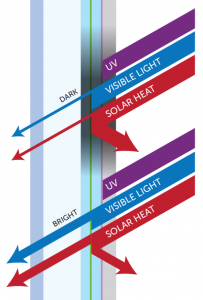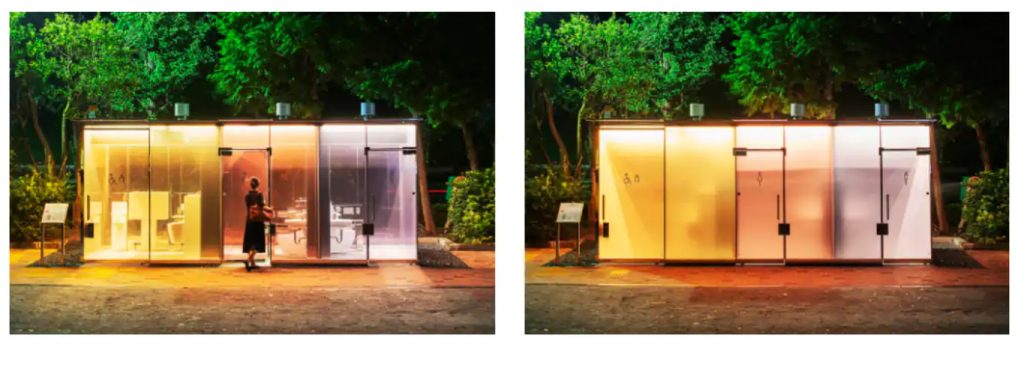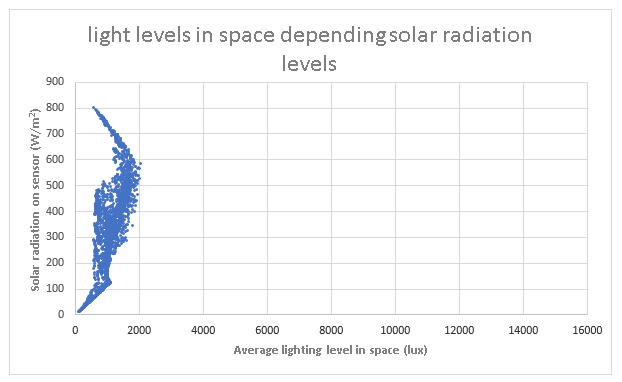What is Smart Glass and is it the future of glazing?
‘Smart Glass’ is glazing that has changeable light and solar transmission values, there are a number of different types of Smart Glass that use different types of technology to alter these properties such as electrochromic, thermochromic and photochromic glazing.
Electrochromic glazing has its light and solar transmission altered when a voltage is applied to the glazing.
Thermochromic glazing has its light and solar transmission altered when heat is applied to the glazing.
Photochromic glazing has its light and solar transmission altered when electro-magnetic radiation is applied to the glazing.
When used in building design, Smart Glass can adapt to the varying climate experienced throughout the year and can create a responsive building envelope.

Diagram from Heliotrope Technologies Inc., showing how electrochromic glazing can allow different amounts of light and solar energy into a space depending on which ‘state’ the glazing is in, not only can light and solar be controlled but they can be so in an independent way.
There are numerous potential advantages to utilising Smart Glass in building design such as:
- Allowing more daylight into the building during winter months when there is less available, whilst also being able to reduce the amount of daylight entering the building during the summer months when excessive levels and glare are more likely to be experienced.
- Prevent the need for external shade systems that may require higher maintenance costs, obscure occupant’s views or even be considered an eyesore.
- Reduce heating demands in the winter and cooling demands in the summer by varying the solar energy allowed into the building.
- Smart Glass can be used for privacy, reducing the light transmittance of the glazing of an occupied room so people can no longer see in.
- Prevent the need for internal blinds that can lead to high glass and blind surface temperatures when there is not sufficient ventilation between the blind and the glass, leading to high radiant temperatures in the space and therefore poor occupant comfort.
- The fact that the glazing parameters can alter means that architects have more flexibility, they can design buildings with a higher proportion of glazed façade with less risk of overheating, glare and high cooling demands.

Photograph of public restrooms in Japan that utilise the adjustable light transmission of Smart Glass to become opaque when occupied.
So is Smart Glass the future of building design and will we see it replace conventional glazing systems? It definitely has its applications and can be of great use for designing buildings in areas that have highly variable climates but with a higher cost and the need for its benefits to be considered at early design stage it may not be for everyone. As production costs start to drop however we could expect to see it installed more regularly, particularly in markets like high end domestic, hotels, and retrofits of buildings currently struggling with the increasing effects of climate change, experiencing high cooling demands and/or occupant discomfort.
Modelling Smart Glass with Dynamic Simulation Modelling (DSM)
Modelling the effects of Smart Glass is obviously much more complicated than modelling standard glazing as the glazing specifications are not static for the yearlong simulation. At EDSL we recently carried out an investigation into how Heliotrope’s electrochromic glazing performed in comparison to more conventional glazing options for a number of different climates. The electrochromic glazing has variable transmission, with extremes called the “bright” state and the “dark” state. Transitions between these two extreme states are changed by applying a voltage across the glass.
The “bright” state was modelled with the following parameters:

The “dark” state was modelled with the following parameters:

As you can see from the light transmittance and G values the dark state of the glazing allows significantly less light and solar energy into the space.
Each EC glazing system has its own solar gain sensor that controls the hourly variation of the panel between ‘bright’ and ‘dark’ states. The optimal control curve (to continuously control to a target average lux level on the working plane) is non-linear and depends on both model geometry and location. Deriving these control curves requires multiple annual daylight simulations, similar to CBDM, which are non-trivial and can be time consuming. The shape of the control curve is obviously important, but the solar gain sensor value at which the EC unit starts to dim is also critical. This whole process of optimising EC control would be intractable without using the multiple cores/threads of modern processors.

Graph of the incident solar gain on the windows and the average lux in the space when using the calculated control curve to control the ‘state’ of the Smart Glass, as you can see the lux levels are held below a value of 2000 lux even when higher solar gain levels are incident. Without the control curve and with the glazing always in its ‘bright state’ lux levels reached an average of up to 14000 lux at some points through the year!
As new technologies become available for building design, thermal modelling software tools must be developed so that the effects of these can be investigated at the design stage. Modelling Smart Glass is no trivial task, at EDSL we are continuing to develop the software to make the modelling of Smart Glass a completely seamless experience for the user.
If you’d like to find out more about Heliotrope’s electrochromic glazing check out their website Heliotrope Technologies – The Next Generation in IGU Evolution
If you have your own Smart Glass or innovative technology project you would like assistance with contact our consultancy department
If you found this blog interesting and would like alerts when we publish blogs join our mailing list here or follow us on Facebook, Twitter or LinkedIn.
